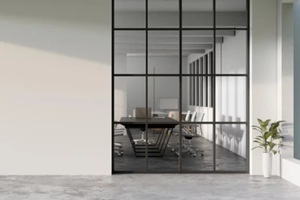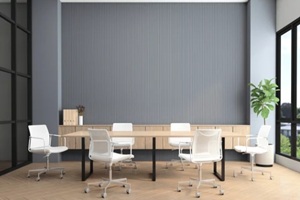 Have you ever sat in a conference room with poor sound control? Maybe it only took two people speaking to make the space sound cacophonous, or perhaps the speaker’s echoing voice was hard to understand. Does outside noise intrude into the room?
Have you ever sat in a conference room with poor sound control? Maybe it only took two people speaking to make the space sound cacophonous, or perhaps the speaker’s echoing voice was hard to understand. Does outside noise intrude into the room?
These invaluable business spaces are often nothing more than cubes or rectangles, which can present problems for sound control. Thankfully, acoustic panels (whether art panels or something else) can help.
Acoustic panels can blend functional noise reduction with aesthetic enhancement to upgrade your conference rooms or executive suites and showcase the best of what your space offers. Quiet is invaluable in these areas; however, to achieve effective noise reduction, you will need to approach your soundproofing project with a smart strategy.
Be sure to do the following:
Think About Brand Image
Yes, your space needs to address its sound problems, but that does not mean you need to relegate your walls or ceiling to drab blocks of noise-dampening materials. Acoustic art panels are available in almost any style and design you can imagine because they are made with customization in mind.
For example, imagine an executive suite featuring an old architectural blueprint of your business, offering class and a sense of industry. How would it feel to have a conference room full of natural imagery for a breath of fresh air? No matter what style you choose, acoustic panels can enhance a space’s aesthetic rather than detract from it.
However, keep your brand image in mind for anyone who will be visiting these spaces. The business’s logo, colors, and font can unify the space when printed on soundproofing panels, creating a cohesive company identity.
Plan Sizing
The way an acoustic panel looks is not the only decision you need to make if you want to be strategic about your project. The size of the panel(s) also matters. In general, bigger does not necessarily mean better; panels that are too large and cover the majority of the room can create an uncomfortably muted environment.
The typical recommendation is to cover around 20% of the wall surface with acoustic control. Professionals can help you determine the appropriate number and size for your situation.
Space the Right Way
 If you plan to use more than one panel for soundproofing, it can be tempting to string them along the wall, making sure they touch so that no surface area is left to bounce sounds back into the room. However, panels should be placed (at a minimum) three inches from each other. In some cases, a foot or more is appropriate. This layout helps to achieve a better balance of noise quality and volume.
If you plan to use more than one panel for soundproofing, it can be tempting to string them along the wall, making sure they touch so that no surface area is left to bounce sounds back into the room. However, panels should be placed (at a minimum) three inches from each other. In some cases, a foot or more is appropriate. This layout helps to achieve a better balance of noise quality and volume.
In addition, consider where the panels are placed. Identify the direction from which the majority of the sound is coming, then install panels opposite that location for the best effect.
Measure the Noise
If you know a space is noisy but are not sure exactly how noisy it is, you could end up choosing panels that are not suited to your needs. Panels are rated using a system called the NRC, or noise reduction coefficient. This scale, from 0 to 1, demonstrates how much sound a panel can absorb.
It’s helpful to gather some information about the decibels and frequency (Hz) of the sound that is intruding in your room(s). This allows professionals to recommend panels that are not just the right size but also the appropriate thickness. A thicker panel is not necessarily always better, so it should be curated to your specific space.
Utilize the Whole Room
Acoustic panels can be a smart and effective way to assist in soundproofing conference rooms and executive suites, but they alone do not need to carry the full weight of that task. Consider how the other elements of the space can contribute.
For example, rugs can deaden noise that might otherwise bounce off the floor. Furniture, plants, or even temporary walls such as privacy screens can intercept some sound waves as long as you know their point of origin.
 If only specific people are struggling with noise issues, consider changing their direction or location in the room. These strategies, along with smart acoustic panel installation, can achieve a high level of soundproofing in a room, whether by deadening sound within the room or by absorbing it before it passes through the walls.
If only specific people are struggling with noise issues, consider changing their direction or location in the room. These strategies, along with smart acoustic panel installation, can achieve a high level of soundproofing in a room, whether by deadening sound within the room or by absorbing it before it passes through the walls.
Make Your Business Spaces Shine with Acoustic Panels
If your business is an uncomfortable space due to the level of sound in your most important rooms, you should address the issue as soon as possible. Comfortable employees work more efficiently with improved morale, happy customers are more likely to return, and great first impressions on potential partners can lead to more collaboration. Contact Tree Towns to share your challenges and begin your custom acoustic panel order!
